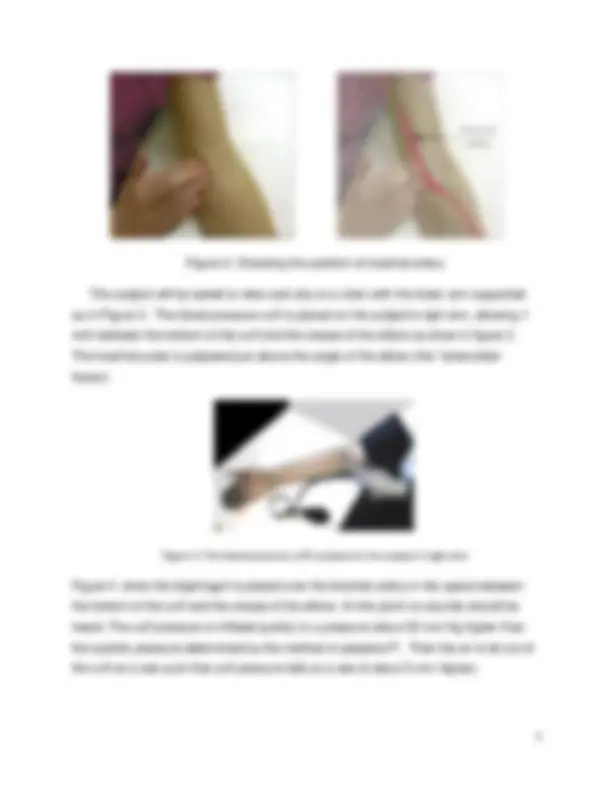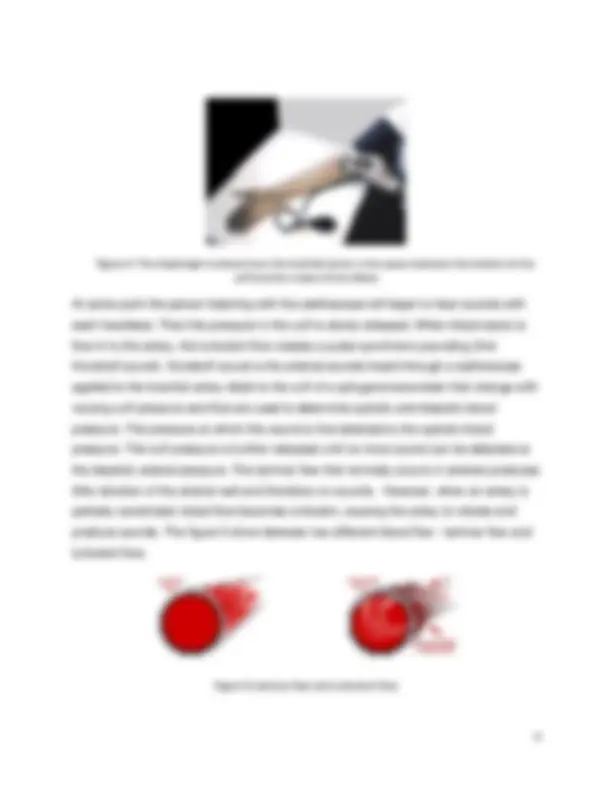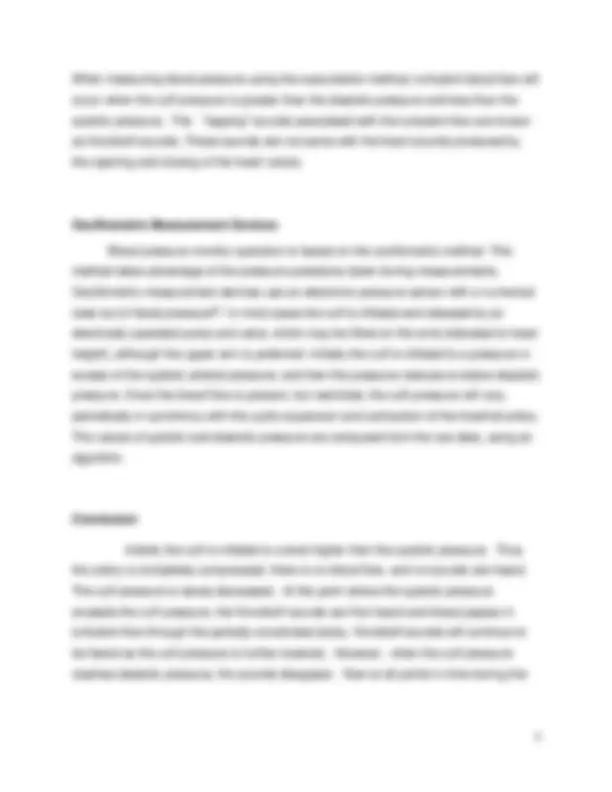





Study with the several resources on Docsity

Earn points by helping other students or get them with a premium plan


Prepare for your exams
Study with the several resources on Docsity

Earn points to download
Earn points by helping other students or get them with a premium plan
Community
Ask the community for help and clear up your study doubts
Discover the best universities in your country according to Docsity users
Free resources
Download our free guides on studying techniques, anxiety management strategies, and thesis advice from Docsity tutors
Blood pressure monitor and management
Typology: Study Guides, Projects, Research
1 / 6

This page cannot be seen from the preview
Don't miss anything!




Introduction
Blood pressure assessment is an integral part of clinical practice. Routinely, a patient’s blood pressure is obtained at every physical examination, including outpatient visits, at least daily when patients are hospitalized before and during most medical procedures. Blood pressure, sometimes referred as arterial blood pressure, is the pressure exerted by circulating blood upon the walls of blood vessels, and is one of the principal vital signs. During each heartbeat, blood pressure varies between a maximum systolic and a minimum diastolic pressure. The blood pressure in the circulation is principally due to the pumping action of the heart. Blood pressure is recorded as two numbers, such as 120/80. The larger number indicates the pressure in the arteries as the heart pumps out blood during each beat. This is called the systolic blood pressure. The lower number indicates the pressure as the heart relaxes before the next beat. This is called the diastolic blood pressure.
Blood Pressure Measurement
Two methods for measuring a blood pressure exist, the direct ( invasive ) and indirect (noninvasive) method. The direct method is the criterion standard and consists of using an intra-arterial catheter to obtain a measurement. This method, however, is not practical due to its invasiveness and its inability to be applied to large groups of asymptomatic individuals for hypertension screening. Therefore, the indirect (noninvasive) method is typically used. The indirect method involves collapsing the artery with an external cuff, providing an inexpensive and easily reproducible way to measure blood pressure. The indirect method can be performed using a manual cuff and sphygmomanometer or with an automated oscillometric device. The manual method requires auscultation of the blood pressure, whereas the automated system depends on oscillometric devices. Usually the auscultatoric measurement is preferred by doctors, the oscillometric method is mainly used in home blood pressure measurement devices.
Auscultatoric Measurement Devices
Auscultatoric measurement devices determine blood pressure by using the sphygmomanometer. A sphygmomanometer , an instrument that measures pressure, is needed in both methods. Each sphygmomanometer consists of a cuff (containing a "bladder") which is connected by lengths of tubing to an inflating bulb with a needle valve and to an aneroid pressure gauge as showed in figure 1.
Figure 1: Sphygmomanometer with aneroid pressure gauge
1.1 Positioning of The Cuff
The center of the sphygmomanometer bladder should be placed over the brachial artery. Many cuffs have some sort of marking scheme so that placement over the brachial artery is under, or just medial to the biceps tendon is facilitated[2]. The lower border of the cuff should be about 2cm proximal to the antecubital fossa and the cuff should be firmly wrapped around the arm. Figure 2 show the position of checking the brachial artery.
Figure 4: The diaphragm is placed over the brachial artery in the space between the bottom of the cuff and the crease of the elbow
At some point the person listening with the stethoscope will begin to hear sounds with each heartbeat. Then the pressure in the cuff is slowly released. When blood starts to flow in to the artery, the turbulent flow creates a pulse synchronic pounding (first Korotkoff sound). Korotkoff sound is the arterial sounds heard through a stethoscope applied to the brachial artery distal to the cuff of a sphygmomanometer that change with varying cuff pressure and that are used to determine systolic and diastolic blood pressure. The pressure at which this sound is first detected is the systolic blood pressure. The cuff pressure is further released until no more sound can be detected at the diastolic arterial pressure. The laminar flow that normally occurs in arteries produces little vibration of the arterial wall and therefore no sounds. However, when an artery is partially constricted, blood flow becomes turbulent, causing the artery to vibrate and produce sounds. The figure 5 show between two different blood flow : laminar flow and turbulent flow,
Figure 5:Laminar flow and turbulent flow
When measuring blood pressure using the auscultation method, turbulent blood flow will occur when the cuff pressure is greater than the diastolic pressure and less than the systolic pressure. The "tapping" sounds associated with the turbulent flow are known as Korotkoff sounds. These sounds are not same with the heart sounds produced by the opening and closing of the heart valves.
Oscillometric Measurement Devices
Blood pressure monitor operation is based on the oscillometric method. This method takes advantage of the pressure pulsations taken during measurements. Oscillometric measurement devices use an electronic pressure sensor with a numerical read out of blood pressure[3]. In most cases the cuff is inflated and released by an electrically operated pump and valve, which may be fitted on the wrist (elevated to heart height), although the upper arm is preferred. Initially the cuff is inflated to a pressure in excess of the systolic arterial pressure, and then the pressure reduces to below diastolic pressure. Once the blood flow is present, but restricted, the cuff pressure will vary periodically in synchrony with the cyclic expansion and contraction of the brachial artery. The values of systolic and diastolic pressure are computed from the raw data, using an algorithm.
Conclusion
Initially the cuff is inflated to a level higher than the systolic pressure. Thus the artery is completely compressed, there is no blood flow, and no sounds are heard. The cuff pressure is slowly decreased. At the point where the systolic pressure exceeds the cuff pressure, the Korotkoff sounds are first heard and blood passes in turbulent flow through the partially constricted artery. Korotkoff sounds will continue to be heard as the cuff pressure is further lowered. However, when the cuff pressure reaches diastolic pressure, the sounds disappear. Now at all points in time during the